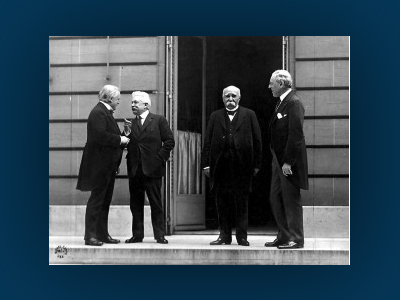Zionist Case Is Presented at Paris Peace Conference

February 3, 1919
A delegation of the Zionist Organization led by Chaim Weizmann presents the case for a Jewish homeland in Palestine to the Paris Peace Conference at the conclusion of World War I. The statement, which included suggested boundaries, proposed that the newly established British Mandate should promote Jewish immigration and settlement, encourage self-government and ensure religious freedoms.
Earlier at the Paris Peace Conference, on January 3rd, Weizmann and Emir Faisal, son of Sharif Hussein of Mecca, had signed an agreement of mutual respect and cooperation. The agreement, which had been negotiated over two meetings in 1918 proposed Jewish support for an Arab nation and Arab support for Jewish settlement in Palestine.
On January 18th, the Peace Conference approved the creation of the League of Nations under which the mandatory system was to be established. The mandatory system of the League of Nations placed European powers like Britain and France in charge of Arab provinces that were previously administered by the Ottoman Empire. These League of Nations trusteeships or mandates gave London and Paris political control over vast areas of the Middle East that later became the countries of Syria, Lebanon, Iraq, Jordan, and Palestine, which later became Israel. Over the course of the Paris Peace Conference, matters pertaining to Europe took center stage, while the issue of control and mandates for the Middle East were continuously postponed, mostly due to the rivalry between Britain and France pertaining to the region. Not until once the British backed off from their support of an independent Syria under Emir Faisal was the issue of the Middle East discussed and an agreement reached.
The early drafts prepared by Weizmann and other Zionist leaders for the conference sought majority rights for Jews in Palestine despite the existing demographics. Eventually those demands were softened and the statement presented on February 3rd accepted the proposed British Mandate and asked that, “Palestine shall be placed under such political, administrative and economic conditions as will secure the establishment there of the Jewish National Home and ultimately render possible the creation of an autonomous Commonwealth, it being clearly understood that nothing shall be done which may prejudice the civil and religious rights of existing non-Jewish communities in Palestine or the rights and political status enjoyed by Jews in any other country.”
On February 6th, Feisal would also address the conference with T.E. Lawrence serving as his translator. Both Feisal and Weizmann either discounted or cared little for the Arabs that were living in the area that would become Palestine, the area west of the Jordan River, north of Sinai, and south of Mt. Lebanon. There was no Arab voice from Palestine at the Paris Peace Conference, and no one really seemed to care.
The photo shows the Paris Peace Conference’s ‘Big Four,’ (from left to right) British Prime Minister David Lloyd George, Italian Prime Minister Vittorio Orlando, French Prime Minister Georges Clemenceau and American President Woodrow Wilson. The ‘Big Four’ would be responsible for almost all of the major decisions at the conference.
To read the complete document from February 3, 1919: http://unispal.un.org/UNISPAL.NSF/0/2D1C045FBC3F12688525704B006F29CC